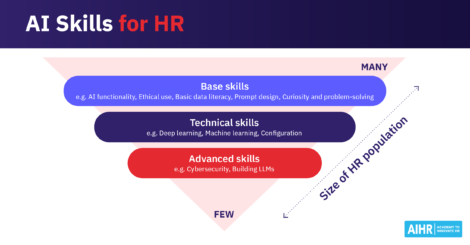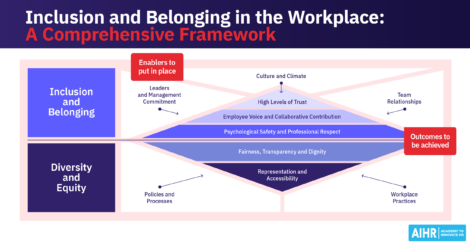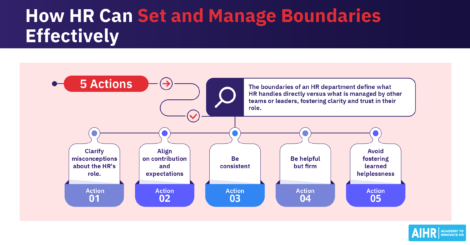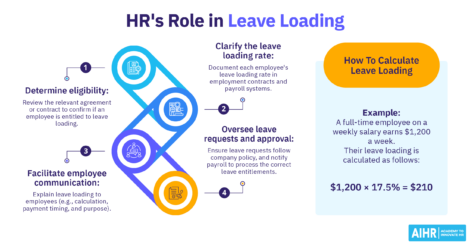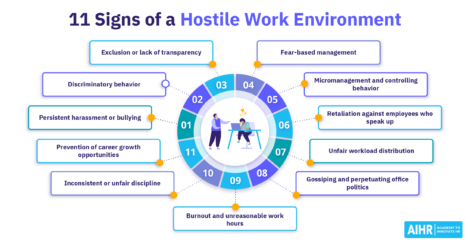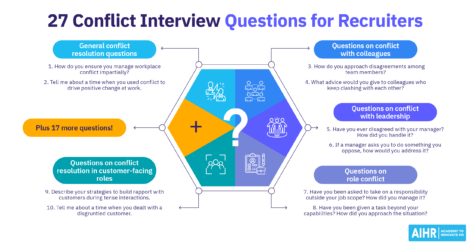How HR Capabilities Evolve with Business Growth [+ 5 Tips for HR Leaders]
“You don’t build a business. You build people, and people build the business,” said author Zig Ziglar. As your business grows, so should your HR capabilities—aligning people, processes, and tools to support that growth every step of the way.
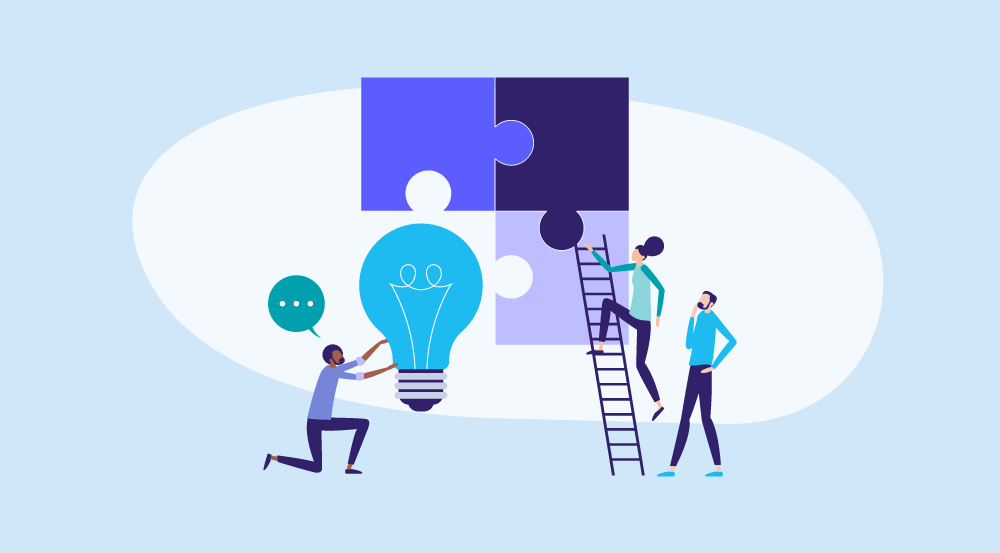
Expectations of HR teams have shifted dramatically. Today’s business leaders look to HR for expertise on emerging topics like ESG, creating cultures of productivity, and addressing challenges related to remote work and generative AI.
To keep up, HR departments must develop new capabilities to adapt to current business needs while also anticipating future requirements. However, our State of HR report reveals that the growth of HR often lags behind that of the business. As such, many HR leaders struggle to identify which capabilities to prioritize at each stage of business growth.
In this article, we explore how to identify, build, and scale HR capabilities in alignment with business growth and strategic objectives.
Contents
HR capabilities across business stages
HR capabilities vs. competencies
5 steps to develop HR capabilities that meet business needs
HR capabilities across business stages
Aligning HR capability development with the stages of business growth ensures that HR functions can consistently contribute to organizational goals.
The business life cycle model is a helpful framework for understanding the challenges and priorities businesses need to solve at each growth stage. Using the lifecycle stages as a guide, we can identify the requirements from HR, which in turn dictate the capability requirements.
Here’s a breakdown of how HR’s focus and capabilities might adapt across the different business lifecycle stages: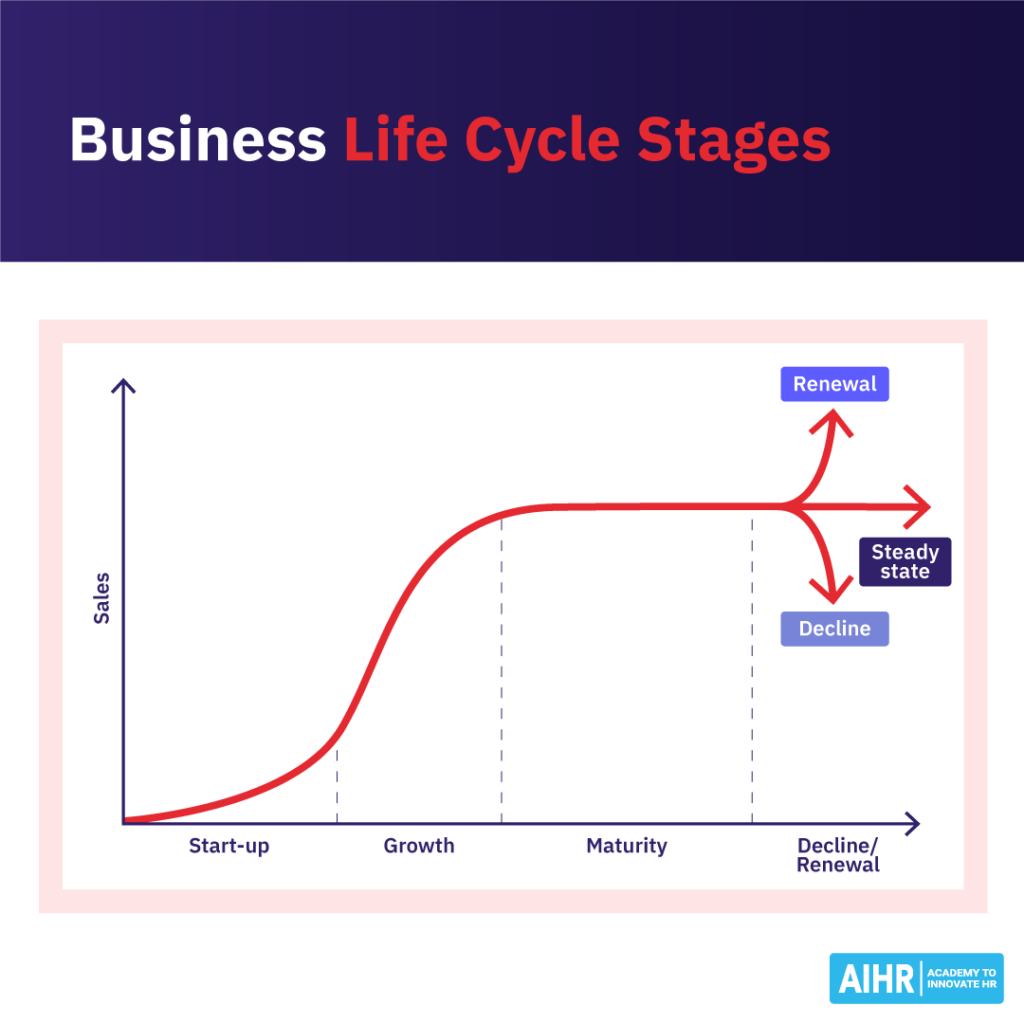
1. Startup stage
The company is focused on proving its value proposition and generating revenue. During this stage, the business consists of the founders and a core team with little structure and resources.
To prepare the business for the next phase, HR has to establish the basic policies, processes, and payroll while also focusing on talent acquisition as a critical priority.
→ Primary HR capabilities: Talent acquisition and setting up foundational HR processes and payroll.
2. Growth stage
The company increases its customer base and builds additional products or services to help scale further. The business starts to formalize, the headcount grows, and the organization begins introducing more structure in responsibilities and roles.
HR has to play a role in stretching current talent and driving a performance culture while also helping the business with the relevant organizational design to execute its growth ambitions.
→ Primary HR capabilities: Talent development, performance management, employer brand, HR Technology and Analytics, Total Rewards, and Organizational design.
We discussed how to structure your HR department for growth and what capabilities you need with Dr. JooBee Yeow, an adviser to start-ups, educator, speaker, writer, and entrepreneur at Learngility. Watch the full interview below:
3. Maturity stage
The company stabilizes operations, manages costs, and seeks new opportunities. At this stage, efficiency becomes a key focus, and HR is tasked with helping drive productivity through people, ensuring the health of the leadership pool, and developing succession and retention plans for critical talent.
Wellbeing becomes an important consideration, and HR has to formalize it as part of the business’s culture. Employee engagement and manager development remain key focus areas, and HR formalizes its strategy and priorities for the long term.
→ Primary HR capabilities: Operational efficiency, leadership development, employee experience and engagement, HR strategy, and succession planning.
4. Renewal or transformation stage
The company focuses on finding new avenues for growth, often engaging in activities such as mergers and acquisitions, aggressive expansion strategies, or developing new products and services.
HR drives these changes for the workforce, aligning workforce capabilities with new business directions and developing reskilling programs to enable execution.
→ Primary HR capabilities: Change management, strategic workforce planning, and reskilling/upskilling.
5. Decline stage (if applicable)
For many companies, this stage is characterized by declining sales, and resources are reallocated elsewhere to maintain profitability. If organizations act quickly, they can move back to the renewal phase, while a lack of action leads to business closure.
HR’s focus during this stage is on guiding employees through these transitions, retaining key talent for essential operations, and managing knowledge transfer to preserve critical organizational knowledge.
→ Primary HR capabilities: Outplacement, retention of critical talent, and knowledge transfer.
To summarize, at the different business lifecycle stages, specific HR capabilities become more important for developing and solving the business’s needs. Although this has to be adapted to the context and needs of each company, below is a generic view of how HR capabilities typically develop in alignment with the business lifecycle.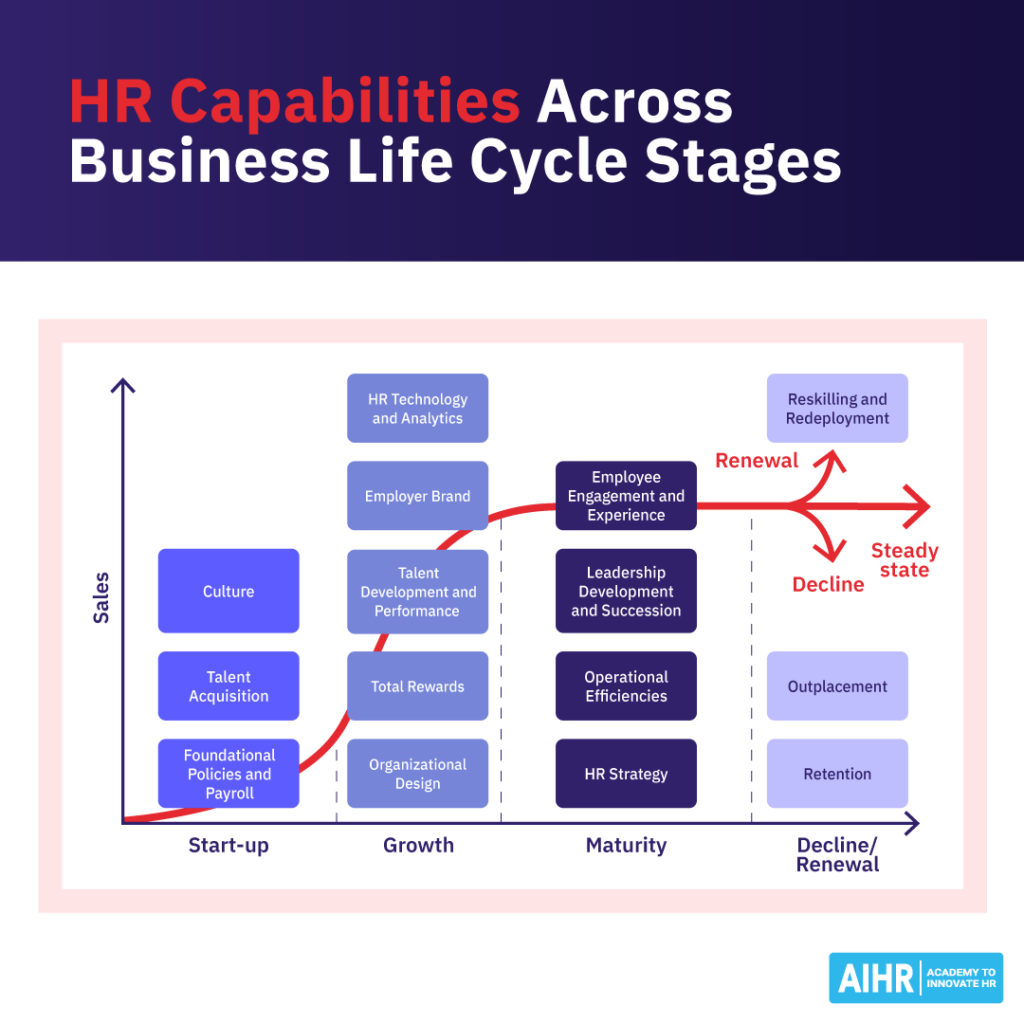
Capabilities developed during earlier stages remain relevant as the organization grows, serving as foundational elements. Maintaining these core capabilities is essential to keep the foundations supporting ongoing growth.
HR capabilities vs. competencies
A competency is a combination of skills, knowledge, and experiences that an individual needs to perform specific tasks or responsibilities. At AIHR, our T-shaped HR Competency Model outlines the key competencies we believe are essential for future HR professionals’ success.
Capabilities, on the other hand, are positioned at a functional or organizational level. They refer to the people, processes, and technology required to achieve strategic goals. Simply put, capabilities answer the question, “What do we, as a team, need to excel at to drive success?” while competencies address, “What skills, knowledge, and experience enable individuals to complete specific activities successfully?”
Understanding the differences between these two concepts is crucial, as building individual competencies is distinct from building functional capabilities. Many organizations mistakenly assume that developing competencies will automatically lead to strong capabilities. However, this limited view often results in highly skilled individuals who lack the necessary tools, processes, or infrastructure to achieve desired outcomes.
5 steps to develop HR capabilities that meet business needs
Building capabilities requires a structured approach that balances the business’s needs with the availability of HR resources and investments. Here are six steps to put the right HR capabilities in place.
Step 1: Identify the HR capabilities relevant to your business
To identify the HR capabilities the organization needs to succeed, it’s essential to clarify what’s expected from HR, understand strategic priorities, and determine how HR can deliver the most value.
The business life cycle stages mentioned above are a helpful starting point for determining which HR capabilities are relevant to the business. Still, it is important to validate which capabilities are relevant to your specific context.
A few guiding questions that can help identify the relevant capabilities are:
- How will we measure HR’s success? Establish key performance indicators (KPIs) to measure HR’s contributions and align them with business objectives.
- What are the business’s top priorities for HR? HR and business leaders should align to clarify which areas need focus, whether it’s talent acquisition, employee experience, or driving organizational change.
- Where can HR have the greatest impact? Identify the capabilities and initiatives that align with strategic goals and address the organization’s most pressing challenges.
Using these questions, the relevant capabilities can be identified and prioritized. Be careful of selecting too many capabilities; instead, focus on the essential capabilities that will drive the biggest business impact.
Implementation tip
If you struggle to identify HR capabilities, it is helpful to refer back to the various functions within HR. Start by focusing on the foundational pillars of HR, as described in this article.
Step 2: Describe your capabilities
After defining the capabilities, the next step is to describe the capabilities in terms of people, process, and technology requirements. This involves answering three key questions:
- What competencies are essential for this capability?
- What processes should be in place?
- What systems and tools are required?
To illustrate how to do this, let’s consider the example of talent acquisition capability.
First, the capability is described in terms of the specific competencies required to source, recruit, and onboard talent. Second, the critical processes for implementing talent acquisition-related outcomes include candidate acquisition, onboarding, reference checks, and sourcing strategies. Third, regarding technology, an Applicant Tracking System (ATS) and the ability to integrate it into the core HRIS will be crucial.
Describing each capability clarifies what will be required to implement it effectively. Once all the necessary capabilities for this stage of the business have been clearly defined, the required capabilities can be prioritized based on their strategic importance to the business and the available resources to build them.
Dr. JooBee Yeow explains a framework she uses to align HR efforts with both immediate and future business needs. She outlines four key priorities:
- HR operations: Ensuring that day-to-day HR processes run smoothly so the business can function effectively. This is the foundational “bread and butter” of HR.
- Driving immediate business goals: Focusing on what the business needs to achieve in the next 12 months, such as hitting specific growth targets or delivering on strategic objectives.
- Future-readiness: Looking two to three years ahead and building the systems and processes today that will enable the business to succeed in the future.
- Scalability: Designing every process and initiative with long-term growth in mind, ensuring efforts today are scalable and don’t create unnecessary work down the line.
This structured approach ensures HR is addressing present needs while, at the same time, laying the groundwork for sustainable success.
Step 3: Categorize your capabilities
Categorizing capabilities helps prioritize which ones to develop based on their strategic importance. While all capabilities add value, their significance can vary depending on the business’s current HR needs. So, put simply, even though all capabilities are required, some require more focus than others.
A helpful framework to use is to draw a capability map. A capability map ranks and prioritizes capabilities in terms of three categories:
- Core essentials: These are essential, foundational capabilities necessary for day-to-day operations. They often cover governance, employee relations, and compliance—areas that require consistent investment to maintain functionality.
- Industry standard: These capabilities align with standard industry practices, providing a solid baseline for HR service delivery. They help ensure that our HR offerings meet basic standards without necessarily exceeding them.
- Strategic differentiators: These are the capabilities that distinguish the organization in the market. They might include a compelling employee value proposition, innovative compensation practices, or flexible work policies, reflecting areas where your business aims to stand out.
Let’s look at an example.
Company ABC is in a scale-up phase and has identified a need to develop capabilities in talent management, policies and procedures, and HR technologies. Given their business stage, they prioritize HR technologies that can effectively manage payroll and offer self-service. They’re not looking for best-in-market solutions but rather for technology that meets current needs without excessive features.
For policies and procedures, they aim to be “as good as the rest.” Practically, this means developing policies that are practical and fit for purpose, investing only as much as necessary to meet standard expectations. Their policies will be aligned with, but not necessarily exceed, those of competitors.
However, they see talent management as a critical capability that can provide a competitive advantage. Therefore, they prioritize building robust talent management processes and dedicated teams focused on attracting and developing top talent. They allocate more resources to the talent management function to fully realize the value.
Once ABC sets these priorities, it can visualize the capabilities through a capability map, which provides a clear overview of focus areas and investment levels.
Below is an example of a capability map drawn for an HR organization aligned to the needs of a business in the “Maturity” phase.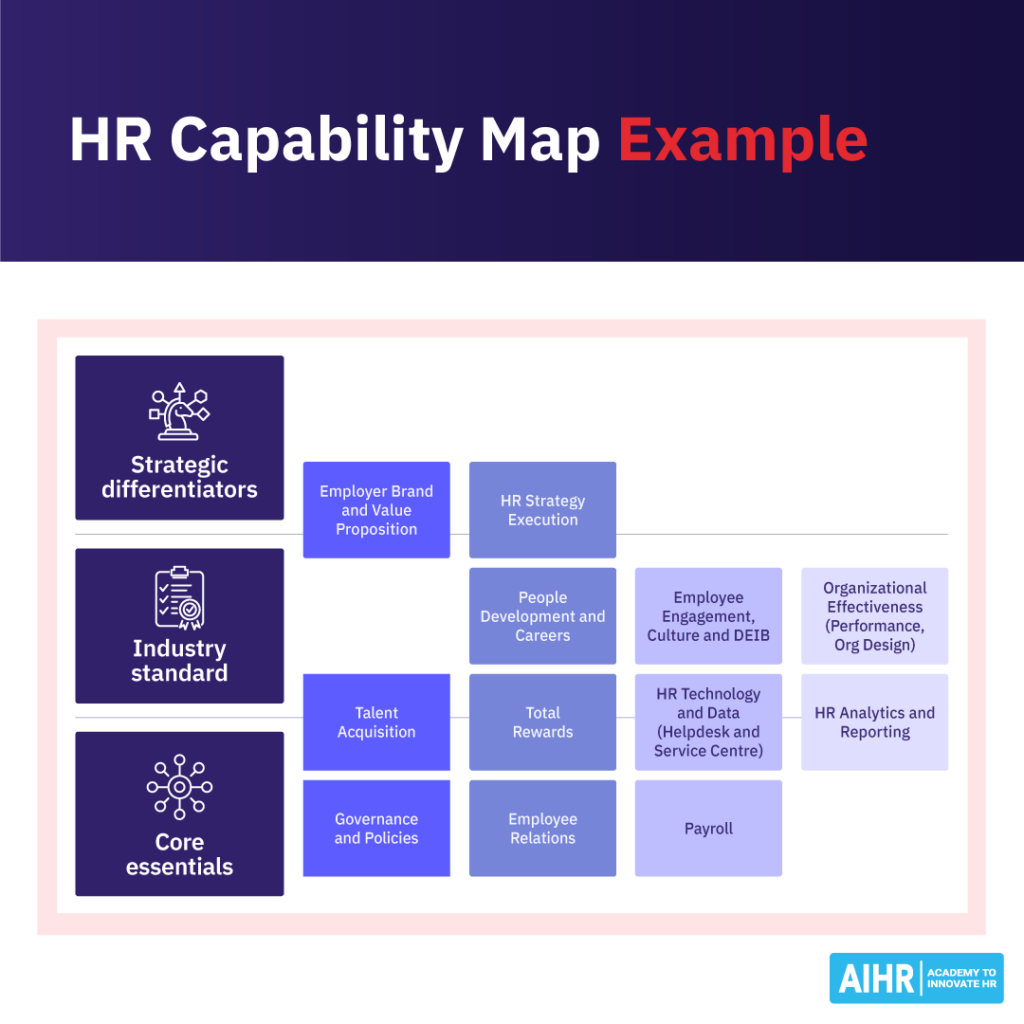
Step 4: Assess current capabilities and identify gaps
With the capability map in place, the next step is to assess the current state of each HR capability. This involves collecting comprehensive data on existing competencies, processes, and technologies using methods such as interviews, assessments, system data analysis, observational studies, and stakeholder feedback. Each capability should be evaluated against defined criteria like effectiveness, efficiency, and scalability.
This analysis should reveal gaps, strengths, and targeted actions to bridge areas needing improvement. For example, if talent acquisition technologies are found to be inadequate, this signals a priority for investment. Conversely, you can earmark capabilities assessed as strong for maintenance rather than further development.
By identifying these gaps and strengths, HR can make informed decisions to align capabilities with business goals and support long-term growth. Findings from this assessment will inform the next step in building a robust, future-ready HR function.
Below is an example of a capability analysis with identified strengths and gaps:Capability Current Status Competencies Processes Systems Talent acquisition Good technologies in place, yet processes are not standardized and skills levels are insufficient to operate at this level. Requires attention Requires attention Strength Payroll technologies Basic systems exist, yet processes remain manual with key individual dependencies. Requires attention Requires attention Sufficient Learning and development No technologies in place to capture and deliver learning, yet strong design and in-person facilitation skills. Strength Sufficient Requires attention
Step 5: Develop and implement capability-building initiatives
With the gaps identified, the next step is to outline a structured capability-building plan that details:
- Key initiatives: What specific actions are needed to strengthen each capability?
- Responsibility: Who will lead each initiative?
- Budget requirements: What financial resources are necessary to support these initiatives?
- Ownership: Who will take accountability for driving these initiatives forward?
Illustrative case example: Developing HR capabilities at Company BTW
Company BTW, now in its maturity stage, has recently completed a transformation following the implementation of a new operating model. They identified several critical areas for improvement within their HR capabilities.
One primary focus was on HR technologies, where an analysis revealed the need for more advanced functionalities than the current system offered. Collaborating with the procurement division, the company selected a new technology vendor equipped to meet these specific functional requirements.
The review further highlighted the need for greater standardization within recruitment processes. To address this, BTW contracted a process engineer to map, optimize, and streamline these processes. This project included introducing standardized templates and metrics, ensuring consistency, and improving efficiency across recruitment activities.
Additionally, the analysis highlighted a skills gap within the learning team, particularly in digital and modern learning methodologies. In response, the team has engaged in a 12-month development program with a learning provider designed to upskill members in contemporary learning design techniques and equip them to deliver more impactful digital learning experiences.
Finally, the review revealed a need to strengthen workforce planning capabilities. Recognizing the importance of this area, the company has prioritized recruiting specialized talent to enhance this function in the coming months.
Final words
Identifying, describing, and developing capabilities are crucial to the success of any HR team. Aligning these capabilities with the business lifecycle stages ensures that HR priorities evolve alongside the company’s needs, from startup to growth, maturity, or reinvention.
Ensuring a structured and holistic approach allows HR teams to execute sustainably and optimize the available resources to invest in capabilities that matter most at each stage of the business journey.
Learn more
Related articles
Are you ready for the future of HR?
Learn modern and relevant HR skills, online







